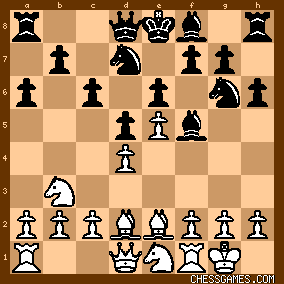| AylerKupp: I did not mean to imply that pawn sacrifices from computers were non-existent or even rare until recently. Far from it. But there are pawn sacrifices and there are pawn sacrifices. The first type of pawn sacrifice, which I will call tactical, happens when the computer can calculate within its search horizon that the pawn will be recovered with interest (more material, overwhelming position, etc.). I will assume that this happens most often when a strong engine plays a weak engine which cannot properly calculate the consequences of accepting the pawn or, ahem, when the computer plays a patzer like myself. But this sacrifice was different. Houdini could not calculate when it played 20.Na1 that it could recover the lost pawn or reach an overwhelming position within its search horizon. Indeed, I can only think of two possibilities: 1. Houdini missed when it played 20.Na1 that it would lose a pawn. Since that would have been apparent in only a 4-ply search and in a game at classical time controls Houdini can achieve search depths in the order of 20 ply. I find this doubtful. 2. Houdini determined that after 21...Qxa2 22.Nc5 Nxc5 23.dxc5 Qa5 24.b4 that it would have an advantageous position, in spite of its pawn minus and doubled c-pawns. This I find impressive. So I can only conclude that this was a positional sacrifice on Houdini's part and that it (correctly) calculated the resulting position to be to its advantage and Rybka did not. Pawn sacrifices of this type are still unusual for engines. It would be very interesting (for those of us who find these kinds of things interesting) to be able to look at the game logs and see how Houdini and Rybka evaluated the position around the 25th move. Here is another example (I was the computer operator for Rybka), perhaps equally interesting: Aylerkupp / Rybka vs Kutztown46 / Stockfish, 2011. In this position Stockfish effectively sacrificed a pawn by 10...h5 and evaluated the position at that point at [+0.60], and at [0.00] when Rybka actually won the pawn after 12.Bxh5.

click for larger viewIn contrast, Rybka evaluated the position at [+0.40] after 10.Ne1 (prior to Stockfish offering the pawn) and at [+0.39] after winning the pawn with 12.Bxh5. So, while Stockfish found the offer of the pawn advantageous if accepted, Rybka considered it pretty much equal to other alternatives. BTW, the game ended in a draw but not without some drama. So, for those who still think that engines cannot play positionally and make positional sacrifices, here is some evidence that they can. It may be rare but, then again, aren't these types of positional pawn sacrifices rare in human games also? | 




